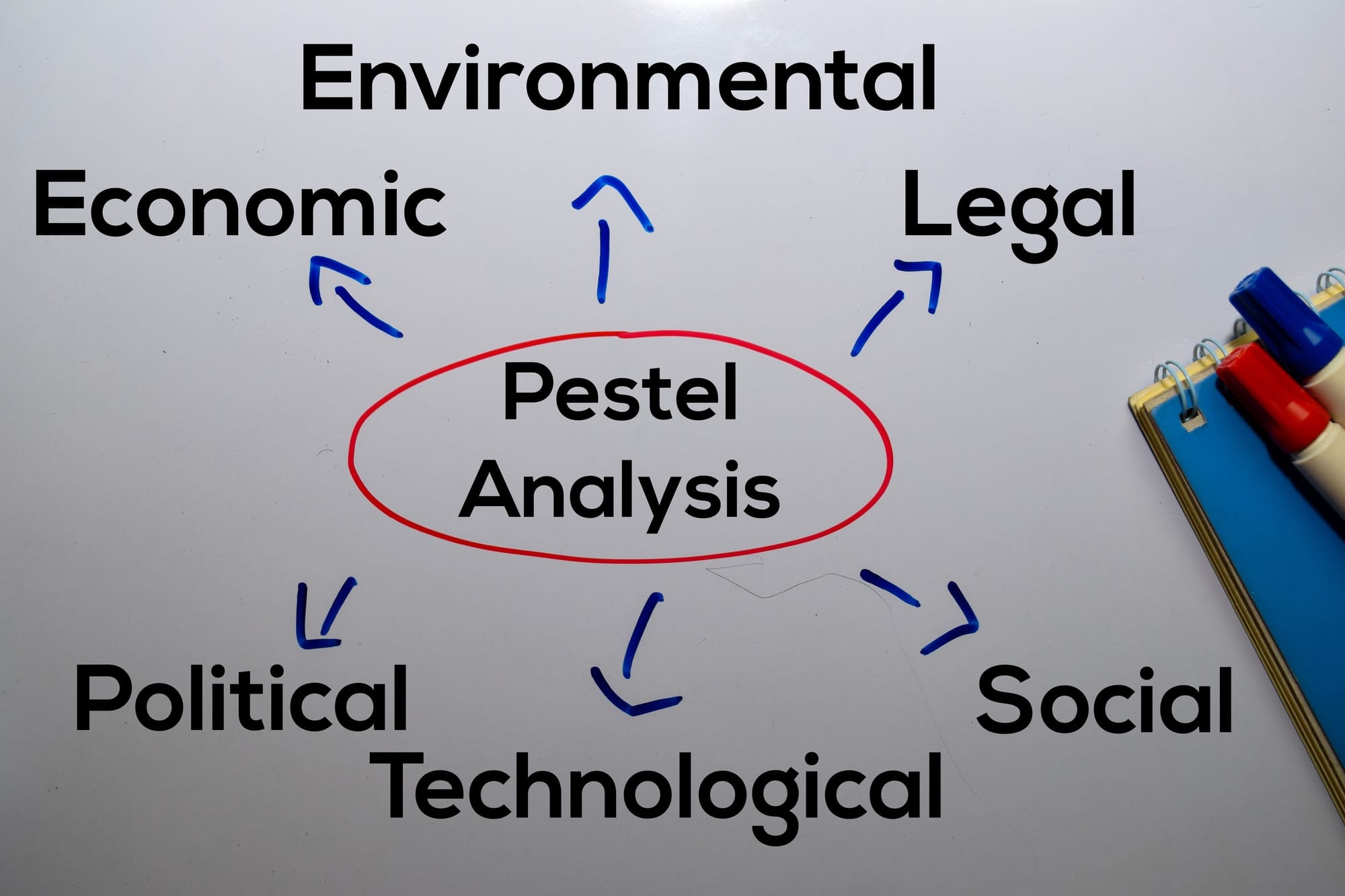Our PESTLE analysis of the Supermarket industry examines the industry's affecting political, social, economic, technological, legal, and environmental factors.
As you wander through the aisles of your local supermarket, you may not realize the complex web of factors that influence the products on the shelves.
From government regulations to cultural trends, the supermarket industry is shaped by many external forces.
To better understand this dynamic environment, we have decided to conduct the PESTLE Analysis of The Supermarket Industry. This PESTLE analysis will examine the political, social, economic, technological, legal, and environmental factors that affect the industry.
Delving into these factors will give you insight into supermarkets' challenges and opportunities. So, grab a shopping cart and join us as we explore what external factors impact the supermarkets.

The history of the supermarket industry can be traced back to the early 20th century when chain stores started emerging as a new retail model. However, the first true supermarket, King Kullen, opened in New York in 1930, offering a wide range of products at low prices in a self-service format.
This concept quickly caught on, and by the 1950s, supermarkets had become a staple of American life. The 1960s saw the emergence of discount stores, which offered products at even lower prices than supermarkets.
This competition forced supermarkets to lower prices and offer more variety to stay relevant. Then, in the 1970s, the industry started to consolidate with the emergence of large chains that had significant buying power, which allowed them to offer even lower prices.
In the 1980s and 1990s, a rise in warehouse clubs and supercenters was seen, such as Walmart and Costco, which offered even lower prices and a more comprehensive range of products, including non-grocery items.
The industry continued to evolve in the 2000s with the advent of online shopping, which led to the emergence of online grocery retailers such as FreshDirect and Instacart.
Today, the supermarket industry is a significant player in the global economy. The size of the supermarket industry was estimated to be $3.18 trillion in 2022. It was further estimated that the global supermarket industry will reach $4.79 trillion in 2026.
The industry is highly competitive, with numerous players vying for market share through various strategies such as pricing, product selection, and customer experience.
Now that we have discussed how the supermarket industry evolved over the years let's proceed further and see what PESTLE analysis is.
PEST analysis is a business tool used by organizations to analyze what external factors impact different businesses and organizations. Now that you guys are aware of what PESTLE analysis is, let's proceed forward and conduct the PESTLE analysis of the supermarket industry.

Political Factors Affecting The Supermarket Industry
The supermarket industry is one of the most significant industries. However, it is affected by various political factors that can either facilitate or hinder its growth and profitability. In this section, we will discuss the political factors that affect the supermarket industry.
Government regulations are among the most significant political factors affecting the supermarket industry. Governments worldwide have imposed various regulations on the industry, which aim to promote fair competition, ensure consumer safety, and protect the environment.
For instance, in the US, the Food and Drug Administration (FDA) has implemented regulations that require supermarkets to disclose nutritional information on food labels. Additionally, many governments have set minimum wage laws, which affect supermarkets' labor costs, which can impact pricing and profit margins.
Another political factor that affects the supermarket industry is taxation policies. Governments use taxes to raise revenue, and the amount and structure of taxes can significantly impact supermarkets.
For example, a government that imposes high sales taxes can decrease consumer spending, reducing supermarkets' profits. Additionally, the imposition of tariffs on imported goods can increase the prices of products sold in supermarkets, affecting consumer behavior and leading to changes in demand.
Moreover, political stability is a crucial factor that affects the supermarket industry. A country's political stability level can impact the overall business environment, affecting supermarkets' operations and profitability.
For example, political instability can lead to changes in government policies, which can affect the regulatory environment for supermarkets.

Economic Factors Affecting The Supermarket Industry
Economic factors refer to the impact of economic conditions and market forces on a particular industry. This section will discuss the PESTLE analysis's economic factors affecting the supermarket industry.
One economic factor affecting the supermarket industry is the state of the global economy. As a result, the global economy can impact the demand for products sold in supermarkets, affecting overall sales and profitability.
For example, during a recession, consumers tend to be more cautious with spending, reducing demand for supermarket products. Additionally, fluctuations in exchange rates can impact the prices of imported goods sold in supermarkets, affecting pricing strategies and profitability.
Another economic factor that affects the supermarket industry is competition. The industry is highly competitive, and the level of competition can impact pricing strategies and profitability.
Large supermarket chains can use their size and bargaining power to negotiate lower prices from suppliers, enabling them to offer lower prices to consumers. Additionally, smaller independent supermarkets may struggle to compete with larger chains, reducing market share and profitability.
Moreover, costs and profitability are also significant economic factors that affect the supermarket industry. Supermarkets have high fixed and variable costs, including labor, rent, utilities, and inventory. The level of these costs can impact pricing strategies and overall profitability.
For example, if the cost of labor increases due to minimum wage laws or other factors, supermarkets may need to adjust their pricing strategies to maintain profitability.

Social Factors Affecting The Supermarket Industry
The supermarket industry is a vital part of society and is affected by various social factors. So let's discuss various social factors that affect the supermarket industry.
One of the most significant social factors that affect the supermarket industry is changing demographics. As the population grows, it becomes more diverse, leading to changes in consumer behavior and preferences.
For example, as the population ages, there may be increased demand for products that cater to the needs of older consumers, such as ready-to-eat meals and health supplements.
Additionally, as the population becomes more diverse, supermarkets may feel the need to adjust their product offerings to meet the needs of different cultural and ethnic groups.
Another social factor that affects the supermarket industry is changing lifestyles. Society is becoming more fast-paced, and consumers increasingly seek convenient, time-saving solutions.
This has increased demand for ready-to-eat meals, online shopping, and home delivery services. Supermarkets must know these trends and adjust their operations and strategies to meet changing consumer needs.
The rise of digital communication and social media is another significant social factor that affects the supermarket industry. Consumers increasingly use social media to share information about products and services, which can impact supermarkets' reputation and brand image.
Additionally, digital communication has increased demand for online shopping and home delivery services, leading supermarkets to invest in e-commerce platforms and logistics capabilities.

Technological Factors Affecting The Supermarket Industry
The supermarket industry is a highly competitive and dynamic, constantly evolving industry. Technology has played a significant role in shaping the supermarket industry and transforming how supermarkets operate. Let's discuss how different technological factors affect the supermarket industry.
Automation and robotics are among the most significant technological factors affecting the supermarket industry. Automation and robotics have transformed supermarkets' operations, increasing efficiency, productivity, and cost savings.
For example, supermarkets can use automated systems to monitor inventory levels and restock shelves, reducing the need for manual labor. Robotics can also perform tasks such as picking and packing, reducing errors and increasing efficiency.
Another technological factor that affects the supermarket industry is the use of data analytics and artificial intelligence. As a result, supermarkets can collect vast amounts of data on consumer behavior, product preferences, and sales trends.
This data can help in developing targeted marketing campaigns, optimize pricing strategies, and improving supply chain management. Artificial intelligence can also automate repetitive tasks, such as data entry.
Besides that, rising mobile technology is another factor affecting the supermarket industry. Mobile apps allow customers to order groceries, track orders, and receive notifications about sales and promotions.
Supermarkets can also use mobile technology to improve the in-store shopping experience by providing real-time inventory information and personalized recommendations.

Legal Factors Affecting The Supermarket Industry
The supermarket industry is subject to various legal factors that affect its operations and profitability. Food safety regulations are a key legal factor affecting the supermarket industry.
Supermarkets are responsible for ensuring that their products are safe for consumption.
They must comply with various food safety regulations, such as the Food Safety Modernization Act, which requires supermarkets to implement preventive controls to minimize the risk of foodborne illness.
Another legal factor that affects the supermarket industry is employment law. Supermarkets are subject to various laws and regulations governing employment practices, such as minimum wage, overtime, and anti-discrimination laws.
They must ensure that their employment practices comply with these laws to avoid legal liability and maintain a positive reputation.
Intellectual property protection is another legal factor affecting the supermarket industry. Supermarkets must ensure that they do not infringe on the intellectual property rights of others, such as trademarks, patents, and copyrights.
They must also protect their intellectual property rights, such as their brand name and logo, from infringement by others. Moreover, competition law is a significant legal factor that affects the supermarket industry.
Supermarkets must comply with antitrust laws designed to prevent anti-competitive practices and promote fair competition. They must not engage in practices such as price fixing, monopolization, or anti-competitive mergers and acquisitions.

Environmental Factors Affecting The Supermarket Industry
The supermarket industry is subject to various environmental factors that affect its operations. Climate change is one of the factors that impact the supermarket industry.
Climate change can affect food production, transportation, and storage, all of which are critical components of the supermarket industry.
For example, extreme weather events can disrupt food production, resulting in shortages or increased prices. Rising temperatures can also increase the risk of food spoilage during transportation and storage.
Moreover, another environmental factor that affects the supermarket industry is waste management. Supermarkets generate significant waste, such as packaging materials, expired products, and unsold food.
Proper waste management is critical to reducing the environmental impact of the supermarket industry. Supermarkets can implement practices such as recycling, composting, and donating unsold food to reduce waste and promote sustainability.
Besides that, supermarkets rely on transportation to transport products from suppliers to stores. Transportation contributes to greenhouse gas emissions, air pollution, and traffic congestion.
Supermarkets can reduce the environmental impact of transportation by using fuel-efficient vehicles, optimizing transportation routes, and using alternative transportation methods such as rail or water transport.

PESTLE Analysis of The Supermarket Industry: Final Word
The supermarket is a trillion-dollar industry that provides employment to millions of laborers. The history of the supermarket industry can be traced back to the 20th century.
Over the years, the supermarket industry evolved and became one of the most significant. So today, we decided to conduct the supermarket industry PESTLE analysis.
This PESTLE analysis highlighted the political, environmental, social, economic, technological, and legal factors that impact the supermarket industry.
This article not only made you aware of what external factors affect the supermarket industry, but it also taught you how to conduct a PESTLE analysis and what is the PESTLE analysis framework.
PESTLE analysis is a handy tool, often used by businesses. We recommend you all look at some examples of PESTLE analysis to get a detailed insight into what PESTLE analysis is.


